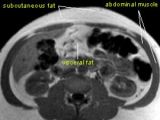Many obesity and fat related symptoms have been regarded as being aggravated by fat consume, but a new research points to the fact that they are induced in fact by fat.
A team from Washington University School of Medicine in St. Louis shows that belly fat could be an important inflammation promoter in conditions like diabetes and cardiovascular disease.
The investigators discovered for the first time that fat cells inside the abdomen are synthesizing molecules that increase inflammation.
Researchers have observed long ago the connection between disease risk and excess belly fat. "Apple-shaped" people, who store fat in the abdomen, are more prone to heart disease, diabetes and other problems than "pear-shaped" people, who accumulate fat in the hips and thighs.
The excessive belly fat is linked to an impairment in the body's response to insulin. There are two types of belly fat: subcutaneous (external) and visceral (internal).
Researches found that only the visceral is harmful; removing the subcutaneous abdominal fat with liposuction does not induce any health metabolic benefits. "Despite removing large amounts of subcutaneous fat from beneath the skin -- about 20 % of a person's total body fat mass -- there were no beneficial medical effects," said Dr. Samuel Klein, the Danforth Professor of Medicine and Nutritional Science. "These results demonstrated that decreasing fat mass by surgery, which removes billions of fat cells, does not provide the metabolic benefits seen when fat mass is reduced by lowering calorie intake, which shrinks the size of fat cells and decreases the amount of fat inside the abdomen and other tissues."
Visceral fat cannot be easily removed by operation, as it is located near the intestines and other viscera. The researchers investigated the blood that runs through the visceral fat (more precisely from portal vein) in 25 obese patients undergoing gastric bypass.
They discovered that the visceral fat was releasing high amounts of an inflammatory molecule called interleukin-6 (IL-6) into portal vein blood, boosting systemic inflammation and insulin resistance. "The portal vein is filled with blood that drains visceral fat," says first author Dr. Luigi Fontana, assistant professor of medicine at Washington University in St. Louis and an investigator at the Istituto Superiore di Sanita, Rome, Italy. "Portal vein blood had levels of IL-6 that were 50 % higher than blood from the periphery."
IL-6 induces the secretion of an inflammatory compound named C-reactive protein (CRP) in the body, whose high levels are connected to chronic inflammation linked to many severe conditions like insulin resistance, hypertension, type 2 diabetes and atherosclerosis. "These data support the notion that visceral fat produces inflammatory cytokines that contribute to insulin resistance and cardiovascular disease," said Klein.
"Many years ago, atherosclerosis was thought to be related to lipids and to the excessive deposit of cholesterol in the arteries. Nowadays, it's clear that atherosclerosis is an inflammatory disease. There also is evidence that inflammation plays a role in cancer, and there is even evidence that it plays a role in aging. Someday we may learn that visceral fat is involved in those things, too", said Fontana.

 14 DAY TRIAL //
14 DAY TRIAL // 
